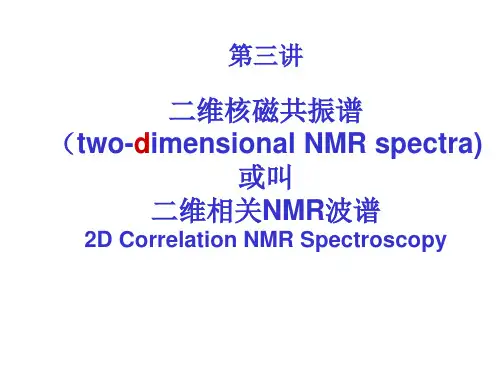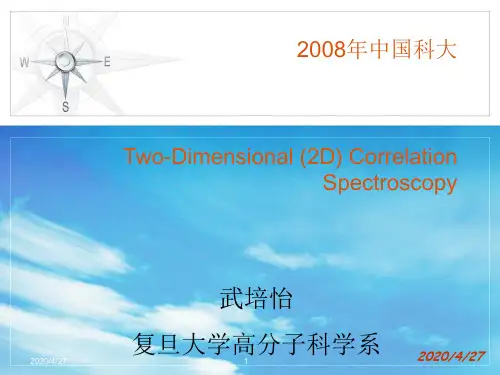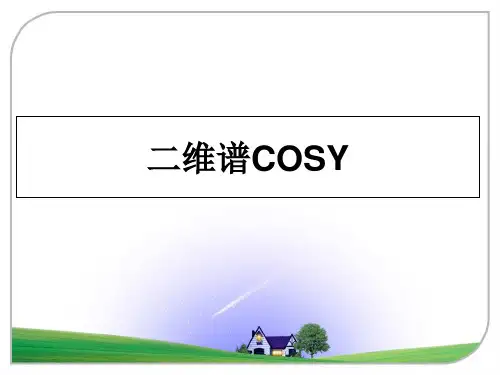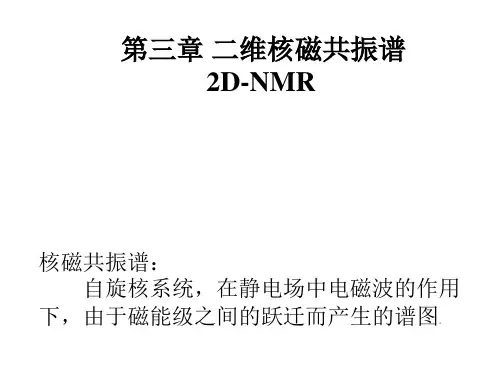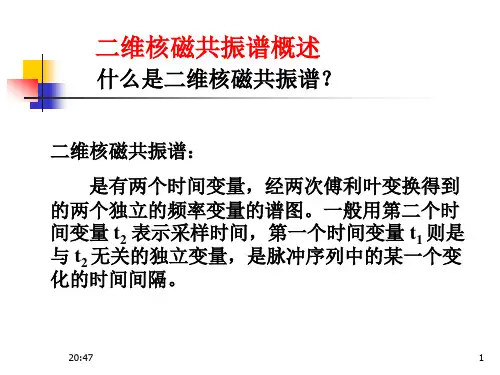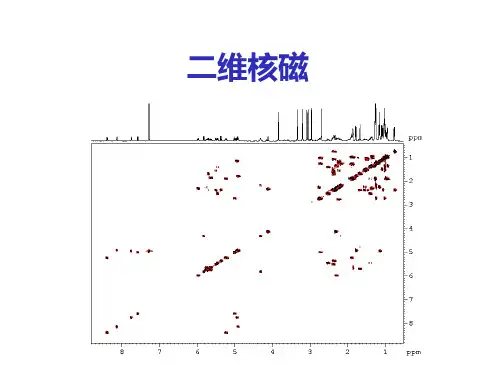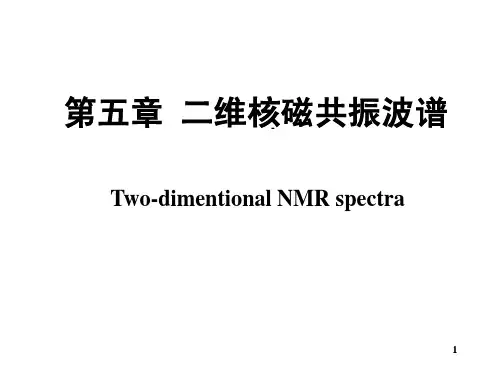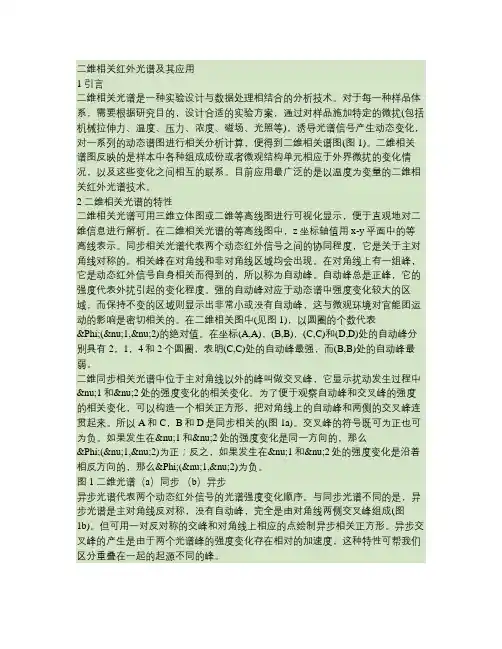- 1、下载文档前请自行甄别文档内容的完整性,平台不提供额外的编辑、内容补充、找答案等附加服务。
- 2、"仅部分预览"的文档,不可在线预览部分如存在完整性等问题,可反馈申请退款(可完整预览的文档不适用该条件!)。
- 3、如文档侵犯您的权益,请联系客服反馈,我们会尽快为您处理(人工客服工作时间:9:00-18:30)。
▪ Generally applicable to a broad range of spectroscopic techniques ▪ Based on a set of spectral data from a system under some perturbation ▪ Either time-dependent or static spectra may be used ▪ Enhance spectral resolution by spreading peaks along the second dimension ▪ Selective development of 2D peaks provides better access to information not
Y~1( )
~y (n 1 , t )
e i t dt
Y~2*( ) ~yBiblioteka n 2 , t)eit dt
2D correlation spectra
1
F(n1,n2 ) i Y(n1,n2 ) (Tmax Tmin )
0
Y~1( ) Y~2*( )
d
F(n1, n2) synchronous spectrum Y(n1, n2) asynchronous spectrum
Temperature, pressure, time, concentration, electromagnetic field ……
2D Correlation Spectra
Acquisition of 2D Correlation Spectra
7
7
2D Correlation Analysis
• DOP aliphatic chains move asynchronously (independently)
with respect to PS phenyl rings
21
2020/7/21
Remola Model of Plasticization
rem’o-ra, n. [L., hinderance.] 1. Any of several fishes (gerera Echenecis, Remora, family Echneididae), with a suctional disk on the head by which they cling to other fishes or to ships. 2. A clog; drags; hinderence.
▪ The sign of a cross peak is positive if the intensity change at n1 occurs before n2.
▪ The sign of a cross peak is negative if the intensity change at n1 occurs after n2.
9
Practical Computational Method
Discrete spectral sampling
~y j
(n
)
y
j
(n
) 0
y(n
)
for 1 j m otherwise
Discrete Hilbert transform
y(n ) 1
m
m
y j (n )
j 1
m
~z j (n2 ) N jk ~yk (n2 )
18
2020/7/21
Human Hair Keratin
Assignments (cm-1) a-helix 1661, 1649
b-like extended chains and turns 1679, 1669, 1645 1641, 1620
Disordered structures 1656
2008年中国科大
Two-Dimensional (2D) Correlation Spectroscopy
武培怡
复旦大学高分子科学系
1
2020/7/21
Two-Dimensional (2D) Spectroscopy
2
2020/7/21
Generalized 2D Correlation Spectroscopy
B. Alpha methyl A. Ester methyl
C. Methylene
S.K. Dirlikov and J.L. Koenig Appl. Spectrosc. 33, 555 (1979).
17
2020/7/21
Atactic PMMA
• Ester methyl peaks are in the synchronous spectrum almost exclusively • Alpha methyl and methylene found in the asynchronous spectrum
14
2020/7/21
Selectively Deuterated Polystyrene
–(CH2CH)n–
–(CD2CD)n–
vs.
15
2020/7/21
Atactic Poly(methyl methacrylate)
16
2020/7/21
Pure Group Frequency Spectra of PMMA
Applied Spectroscopy, vol. 54, no. 7, July, 2000. (Special issue on generalized 2D correlation spectroscopy)
Y. Ozaki and I. Noda, Eds. Two-Dimensional Correlation Spectroscopy, AIP Conference proceedings 503, AIP: Melville, 2000.
▪ The above sign rules are reversed if F(n1, n2)<0.
12
Polystyrene/Polyethylene Blend
Polystyrene
–(CH2CH)n–
Polyethylene
–(CH2CH2)n–
• PS and PE are immiscible (phase separated) • No molecular level interactions
(n1,n2) ~y(n1,t) ~y(n2,t')
= F(n1,n2) + i Y(n1,n2)
Synchronous spectrum F(n1,n2) = Similarity of signal dependence on t
Asynchronous spectrum Y(n1,n2) = Dissimilarity of signal dependence on t
5
Book
6
Generalized Two-Dimensional Correlation Spectroscopy
Electromagnetic Probe IR, NIR, laser ……
Chemical System
Dynamic Spectra
External Perturbation
▪ Cross peaks represent simultaneous changes of spectral signals at two different wavenumbers, suggesting a coupled or related origin of intensity variations
19
2020/7/21
Polystyrene/DOP Blend
Dioctyl phthalate (DOP)
Perdeuterated polystyrene
20
2020/7/21
Plasticized Polystyrene
• Motions of aromatic groups of PS and DOP are synchronized
Perturbation
S(t)
Input
I(n)
System
Output
~y (n1,t)
~y(n 2,t) ...
~y (n n ,t)
Comparison of two signals
measured at different n along t
Cross-correlation function
readily observable in conventional 1D spectra ▪ Sign of cross peaks to determine relative direction of intensity changes and
sequential order of events ▪ Comparison of different spectral data via hetero-correlation
10
Synchronous correlation spectrum: F(n1, n2)
▪ Autopeaks at diagonal positions represent the extent of perturbation-induced dynamic fluctuations of spectral signals
▪ If the sign of a cross peak is positive, the intensities at corresponding wavenumbers are increasing (or decreasing) together. If the sign is negative, one is increasing, while the other is decreasing.

